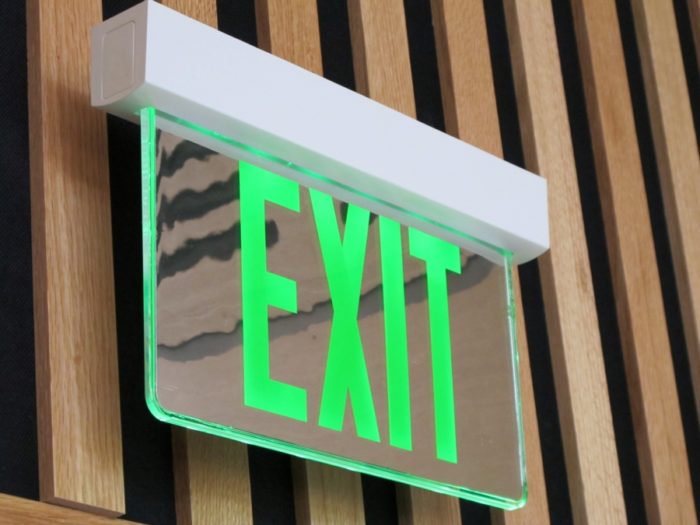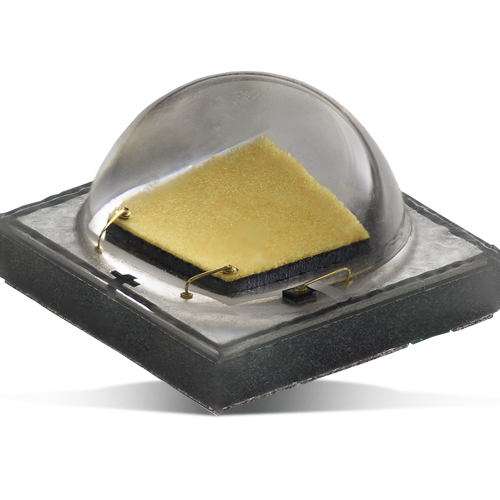
Image Credit: Alex Wilson
In the years that I’ve been writing about energy and energy conservation (longer than I really want to admit), I’ve reported on several dramatic transitions in how we illuminate the exit signs in commercial buildings. For an energy geek, it’s been an exciting technology to watch.
Why care about exit signs?
Why do we even pay attention to exit signs—those ubiquitous red or green illuminated signs that direct our escape from a building should the need arise? They can’t use very much energy, can they?
Each one uses relatively little electricity, but they are on all the time. And we have a lot of them in our schools, factories, and office buildings. The U.S. Environmental Protection Agency estimates that there are more than 100 million exit signs in use today in the U.S., consuming 30–35 billion kilowatt-hours (kWh) of electricity annually.
That’s the output of five or six 1,000 MW power plants, and it costs us $2-3 billion per year. Individual buildings may have thousands of exit signs in operation.
From incandescent to fluorescent to LED
When I first wrote about exit signs, the vast majority of them were illuminated with two 15- or 20-watt incandescent lamps. These lamps often lasted less than a year, and an exit sign with two of these lamps used nearly as much electricity per year as an Energy Star refrigerator uses today. For businesses, the labor cost of replacing those incandescent bulbs could be nearly as expensive as the electricity they consumed.
Thus, there was a lot of excitement in the early 1980s when compact fluorescent lamps (CFLs) made their way into exit signs. One or two CFLs using a total of 10–15 watts replaced up to 40 watts of incandescent lighting, and they lasted several times as long. The low power factor of these CFLs actually reduced the energy benefit for utility companies (a complex issue that I won’t bore you with), but end-users saved a lot of money. The biggest downside was the small amount of mercury in each CFL.
CFL lighting for exit signs didn’t last long, however. By the early 1990s, LED technology emerged for exit signs. LEDs are solid-state lighting devices that use relatively little electricity, do not require mercury (as is required in fluorescent lamps), and last a very long time. Early LEDs were usually red or green (think of those indicator lights on your stereo equipment), which worked fine in exit signs. (White LED lighting for general illumination is a lot more challenging.)
The first LED exit signs dropped the electricity use down to 5–7 watts, and there are LED exit signs on the market today that use as little as 1.8 watts and still meet the emergency egress standards of building codes.
Energy efficiency regulations gave a huge boost to LED exit signs. A revision of the Energy Policy Act of 2005 set a maximum electricity consumption of exit signs at 5 watts (effective in January 2006), which effectively eliminated both incandescent and CFL exit signs.
With such low electricity consumption, LED exit signs can be coupled with relatively small battery back-up systems—a requirement (and significant environmental impact) for most exit signs.
Just as significant for bottom-line-conscious businesses is the very long life of LEDs. Most are rated at 50,000 hours—many times as long as incandescent lamps. The power factor is also better than that of CFL exit signs, which makes utility companies happy.
Enter electroluminescent exit signs
There isn’t a lot of additional gain to be squeezed out of a 2-watt LED exit sign, but there is some. A quite different technology allows fully compliant exit signs to be powered with less than a fifth of a watt—at least a ten-fold drop compared with most LED products.
Electroluminescent or light-emitting capacitor (LEC) technology produces a uniform layer of light rather than discrete point sources (as with LEDs). Limelite Technologies, the leading manufacturer of electroluminescent exit signs, describes how the technology works on its website.
Again, the savings from each one isn’t that great, but spread over tens of millions of products, the savings could be very significant.
Exit signs in our GreenSpec Directory
In our GreenSpec product database, we briefly listed CFL exit signs, then included dozens of manufacturers of LED exit signs. Today we list just two products: LimeLite of Maxwell, Texas, which produces the Series 16 and Design Select exit signs, consuming just 0.18 watts each; and Greentorch, which makes a wide range of LED exit signs including an LEC model using 0.25 watts and having an expected life of 30 years.
Exit signs to avoid
While there is a lot of good stuff in the exit sign world, there are some products to watch out for. One of them is “zero-energy” photoluminescent exit signs, which harvest ambient light from the space and will deliver needed emergency exit sign illumination for up to a couple hours during a power outage. These use glow-in-the-dark materials that are familiar in toys.
The problem is that code requires fluorescent lights to shine on these photoluminescent exit signs so that they will be fully charged and ready to provide that emergency illumination during a power outage. You will use more energy for the fluorescent light source to charge the exit sign than a standard LED exit sign will use to operate. Yes, the battery can be eliminated, but that still doesn’t justify the additional electricity use (in most cases).
The other product I like to stay away from is radioluminescent, or tritium-powered, exit signs. Tritium, a radioactive isotope of hydrogen, provides the illumination. While tritium emits fairly low-energy beta particles that aren’t strong enough to penetrate our skin, if we breathe in tritium gas or swallow tritiated water, the radiation can damage cells in our body. It’s a product I’d rather keep away from.
A detailed summary of exit sign technologies, including discussion of why photoluminescent products don’t make sense, is available in our EBN feature article on the evolution of exit signs, though this requires a log-in.
Alex is founder of BuildingGreen, Inc. and executive editor of Environmental Building News. He is also founder of the new nonprofit Resilient Design Institute. To keep up with Alex’s latest articles and musings, you can sign up for his Twitter feed.
Weekly Newsletter
Get building science and energy efficiency advice, plus special offers, in your inbox.















One Comment
Easy money
Nice post, Alex. Any building that still uses incandescent exit signs has easy money awaiting them when they convert to LEDs. I did an audit for a hostel in California three years ago, and my top recommendation to them was to replace all their incandescent exit signs with LEDs. Doing so, they'd save about $1000 per year on electricity for a capital investment of $600.
As you say, exit signs are ubiquitous, which makes them almost invisible. I think a lot of buildings have already made the change, but any that haven't need to make the upgrade and grab that easy money.
Log in or create an account to post a comment.
Sign up Log in